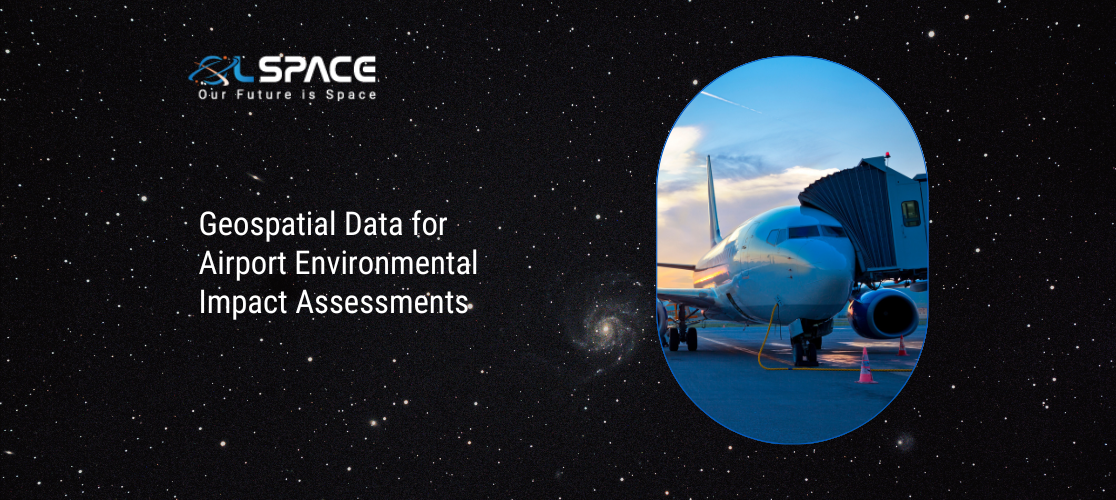15 December 2023
Geospatial Data for Airport Environmental Impact Assessments

Airports are vital hubs of connectivity, linking regions and facilitating global travel. However, their expansion and operation can have significant environmental implications. Geospatial data, encompassing satellite imagery, GIS (Geographic Information System), and remote sensing technologies, plays a pivotal role in conducting thorough Environmental Impact Assessments (EIAs) for airports. This article explores how geospatial data contributes to assessing and mitigating the environmental impact of airport development and operations.
1. Site Selection and Land Use Planning:
Satellite Imagery: Geospatial data provides detailed satellite imagery to aid in the selection of suitable airport locations, considering factors such as terrain, proximity to urban areas, and environmental sensitivity.
GIS Analysis: Geographic Information Systems analyze land use patterns, helping planners understand the existing environment and make informed decisions about airport site selection.
2. Noise Impact Modeling:
Flight Path Analysis: Geospatial tools model flight paths and analyze the potential noise impact on surrounding communities.
Topographic Mapping: GIS helps assess how terrain features may affect noise propagation, allowing for informed decisions on runway placement and flight patterns to minimize noise pollution.
3. Air Quality Monitoring:
Sensor Integration: Geospatial technologies integrate data from air quality sensors, satellite observations, and meteorological sources.
Spatial Analysis: GIS spatial analysis assesses the dispersion of pollutants, helping identify potential air quality impacts on local ecosystems and communities.
4. Vegetation and Habitat Mapping:
Satellite and Aerial Imagery: High-resolution imagery aids in mapping and monitoring vegetation and habitats in and around airport areas.
Change Detection: GIS-based change detection tools help track alterations in vegetation cover, facilitating the assessment of potential impacts on local biodiversity.
5. Water Resource Management:
Hydrological Modeling: GIS enables hydrological modeling to assess the potential impact of airport development on water bodies and drainage patterns.
Watershed Analysis: Spatial analysis tools assess the impact of runoff and pollutant discharge, contributing to sustainable water resource management.
6. Visual Impact Assessment:
Viewshed Analysis: Geospatial data is used for viewshed analysis to evaluate the visual impact of airport structures on the surrounding landscape.
3D Visualization: GIS-based 3D visualization tools enhance the understanding of how airport developments may alter the visual aesthetics of the area.
7. Wildlife Hazard Management:
Remote Sensing: Satellite and aerial imagery aid in identifying wildlife habitats and migration patterns.
GIS Analysis: GIS is employed to analyze potential wildlife hazards, helping design measures to mitigate the risk of bird strikes and other wildlife-related incidents.
8. Climate Change Resilience:
Climate Modeling: Geospatial data contributes to climate modeling, assessing the potential impact of airport operations on local climate conditions.
GIS for Adaptation Planning: GIS is utilized for adaptation planning, helping airports enhance resilience against climate change impacts.
9. Socio-Economic Impact Analysis:
Demographic Mapping: GIS-based demographic mapping provides insights into the socio-economic conditions of nearby communities.
Accessibility Analysis: Spatial analysis tools assess how airport development may impact accessibility, employment opportunities, and overall socio-economic well-being.
10. Regulatory Compliance and Reporting:
Spatial Data Infrastructure (SDI): Geospatial technologies facilitate the creation of SDIs for storing, managing, and sharing environmental data.
Compliance Mapping: GIS helps visualize and map compliance with environmental regulations, supporting the reporting requirements of environmental impact assessments.
Conclusion: A Holistic Approach to Environmental Stewardship
Geospatial data is an indispensable tool in the aviation industry’s commitment to responsible and sustainable development. By harnessing the power of satellite imagery, GIS, and remote sensing technologies, airports can conduct comprehensive environmental impact assessments. This holistic approach not only ensures regulatory compliance but also fosters environmental stewardship, guiding airports towards sustainable practices that balance the demands of air travel with the preservation of the natural and social ecosystems surrounding them.
